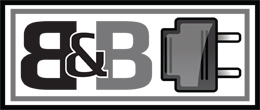How does solar electricity work? This seems to arise with each generation as they explore alternative energy options. Most people know that solar power requires the use of solar panels, however, beyond that there’s little understanding of how the system works.
Here at B & B Electric we want to demystify solar power. It’s important to us that everyone understands all their power options. When you understand all of the options available to you, you can then make an educated decision about which route you’d like to go when it comes to powering your home.
So How Does Solar Electricity Work?
The typical option when it comes to residential solar power is a photovoltaic system, also known as a solar PV system. The entire system is composed of solar panels and other parts. These include an inverter, meter, cabling, mounting, etc.
Solar PV systems are electrical systems which require very little maintenance for a number of years. If the system is used in an area with the optimal quantity of sunlight it could save you money in addition to being a green alternative to other options. We’ll get to all of that, but first we want to answer the question:
How Does Solar Electricity Work?
The job of the solar panels is to collect sunlight then change it to DC electricity which then, with the help of an inverter, becomes AC electricity. Your system’s meter will track the quantity of electricity produced from the solar panels. Some solar PV systems also use batteries to store any unused electricity.
This is the basic idea of how solar electricity works. The actual process is slightly more technical than this. We will take a deeper look at solar electricity and answer some of the most commonly asked questions.
The Technical Side of Solar Electricity
Solar panels consist of solar cells. These are also commonly known as photovoltaic or PV cells. They create electricity while they absorb sunlight. The cells themselves are made of materials such as crystalline silicon.
Solar modules are groups of solar cells. A single module produces a limited amount of electricity. Solar modules connect to form a solar panel. The modules and panels themselves can vary in effectiveness depending on how many solar cells they contain.
The type of electricity produced by the solar panels is called direct current, also known as DC. Direct current means the electric charge flows in one constant direction. In order to use the electricity in your home it must first be converted to alternating current, or AC. Alternating current means the charge occasionally reverses in direction. The DC to AC conversion is done with an inverter.
Another important part of a solar power system is a bi-directional meter. When your home pulls electricity from the power grid in your area your meter moves forward. Your solar power system will generate electricity for your home but the excess electricity flows into the power grid. When this happens, your meter will reverse. This type of metering is referred to as “net metering.” Your local utility company should credit your bill for any excess electricity that flows back into the power grid. Some systems use batteries to store the excess electricity rather than pushing it back into the power grid.
Frequently Asked Questions
How Much Power Does Solar Power Generate?
The answer depends largely on where you live. You can find a solar PV map on The National Renewable Energy Laboratory, or NREL, website. The map offers an idea of the average solar power generation throughout the course of a year. This number displayed is solar insolation. Solar insolation is the standard measurement unit in the solar power industry.
Of course your location on the map isn’t the only thing to take into consideration. Local weather conditions and environment also play a part. For example, large shade trees which block light from reaching your solar panels during part of the day can reduce effectiveness.
How Much Money Will I Save With Solar Power?
The answer to this question can also be tricky. There’s no single answer that’s the same for everyone. Your savings depend on how much energy you consume along with how much energy your solar PV system generates.
How Expensive is a Solar Power System?
This also depends on a number of factors. A typical solar PV residential system tends to cost between $25,000 and $35,000. Many homeowners either get a loan or a power purchase agreement, also known as a PPA, to finance the purchase. Some companies offer leasing options for solar PV systems as well. Be sure to research each financial option to determine which is right for you.
You may also qualify for federal or state renewable energy tax credits. If you install a solar PV system before the end of 2019 you may be eligible to earn a tax credit of 30 percent of qualified expenses. Many states also have tax credits and incentives.
Installing and Repairing Solar Power Systems
In addition to answering the question “How does solar electricity work?” Our staff can answer any other questions you may have about powering your home.
There are many factors to take into consideration when choosing a solar power system for your home. You’ll want to ensure you have the most efficient and effective system possible. This also includes finding the optimal location to install your solar panels. Many of these decisions can be overwhelming for homeowners. B&B Electric wants to help make the process of installing or repairing a solar power system as easy as possible.
Our expert staff can also help with any of your other electrical needs. Great customer service is our goal and we will do whatever we can to ensure your electrical system is safe and efficient. Please give us a call today to learn more about our services and rates.
